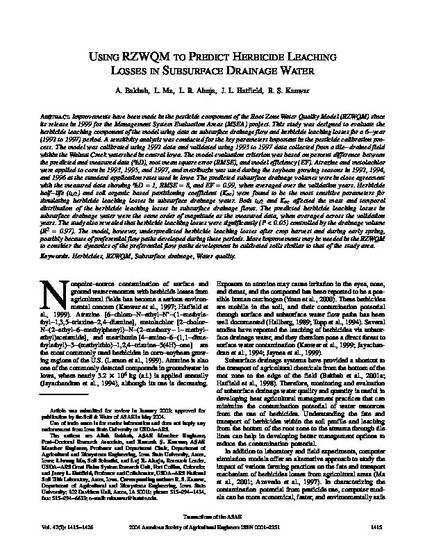
If you are not an ASABE member or if your employer has not arranged for access to the full-text, Click here for options. USING RZWQM TO PREDICT HERBICIDE LEACHING LOSSES IN SUBSURFACE DRAINAGE WATER
Published by the American Society of Agricultural and Biological Engineers, St. Joseph, Michigan www.asabe.org Citation: Transactions of the ASAE. Vol. 47(5): 1415-1426 . (doi: 10.13031/2013.17621) @2004 Authors: A. Bakhsh, L. Ma, L. R. Ahuja, J. L. Hatfield, R. S. Kanwar Keywords: Herbicides, RZWQM, Subsurface drainage, Water quality Improvements have been made in the pesticide component of the Root Zone Water Quality Model (RZWQM) since its release in 1999 for the Management System Evaluation Areas (MSEA) project. This study was designed to evaluate the herbicide leaching component of the model using data on subsurface drainage flow and herbicide leaching losses for a 6-year (1992 to 1997) period. A sensitivity analysis was conducted for the key parameters important in the pesticide calibration process. The model was calibrated using 1992 data and validated using 1993 to 1997 data collected from a tile-drained field within the Walnut Creek watershed in central Iowa. The model evaluation criterion was based on percent difference between the predicted and measured data (%D), root mean square error (RMSE), and model efficiency (EF). Atrazine and metolachlor were applied to corn in 1993, 1995, and 1997, and metribuzin was used during the soybean growing seasons in 1992, 1994, and 1996 at the standard application rates used in Iowa. The predicted subsurface drainage volumes were in close agreement with the measured data showing %D = 1, RMSE = 8, and EF = 0.99, when averaged over the validation years. Herbicide half-life (t1/2) and soil organic based partitioning coefficient (Koc) were found to be the most sensitive parameters for simulating herbicide leaching losses in subsurface drainage water. Both t1/2 and Koc affected the mass and temporal distribution of the herbicide leaching losses in subsurface drainage flows. The predicted herbicide leaching losses in subsurface drainage water were the same order of magnitude as the measured data, when averaged across the validation years. The study also revealed that herbicide leaching losses were significantly (P < 0.05) controlled by the drainage volume (R2 = 0.97). The model, however, underpredicted herbicide leaching losses after crop harvest and during early spring, possibly because of preferential flow paths developed during these periods. More improvements may be needed in the RZWQM to consider the dynamics of the preferential flow paths development in cultivated soils similar to that of the study area.
Available at: http://works.bepress.com/rskanwar/117/

This article was published in Transactions of the ASAE Vol. 47(5): 1415-1426, doi:10.13031/2013.17621.